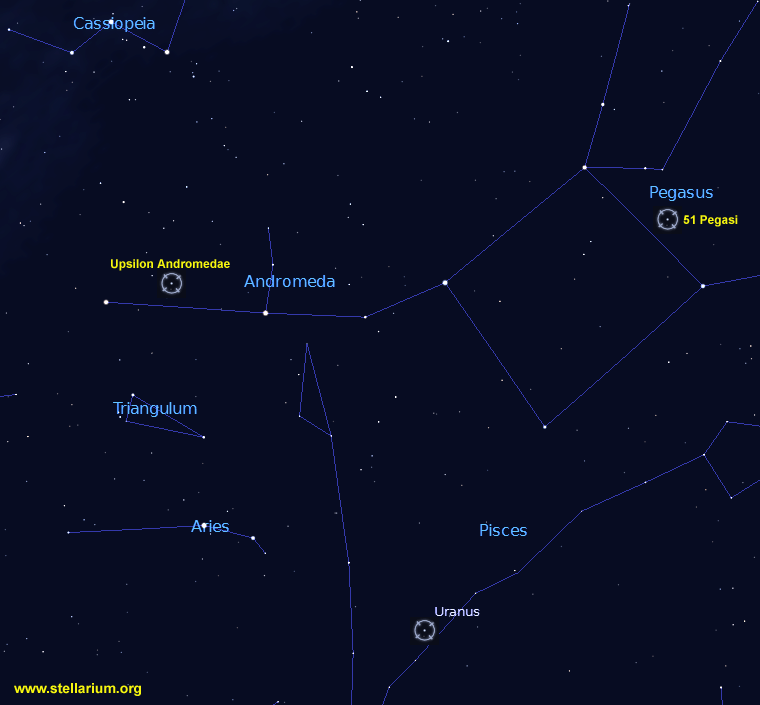Since the dawn of time, humans have gazed at the stars for entertainment. Over the centuries, novice sky watchers noticed certain bright objects move across the starry back ground over the course of weeks, months and even years. These were the planets of our solar system. The word planet comes from the Greek meaning “wanderer”. Only five of our planets could be seen with just your eyes until the discovery of Uranus, Neptune and Pluto after the invention of the telescope in 1608.
Throughout antiquity, astronomers and visionaries looking up at the stars, had long thought there must be other planets around those distant points of light, just as our planets circles our daytime star – the Sun. Some visionaries went on to suggest and preach that life might exist on some of these worlds. Once a vision of a few has now become discovery for all. Today’s technology is helping unlock the deep and mysterious secrets of the universe. It turns out; the sky is not a collection of stars but solar systems.
In 1992 the first two exoplanets (planets that orbit a star outside the solar system) were discovered orbiting a pulsar with a third exoplanet discovered in that system in 1994. A pulsar emits high levels of radiation which would make it almost impossible for life to exist. Never the less – round planets orbiting a distant star was big news.
Then came the discovery in October of 1995 of the first exoplanet discovered orbiting a star just like our Sun. Observations with earth based telescope revealed the star had a tiny back and forth wobble thus indicating one or more planets are tugging at it. Turns out only one world exists around a star catalogued 51 Pegasi.
51 Pegasi is located 50 light years from Earth with its planet named Dimidium orbiting only 7 million kilometres or nine times closer than the planet Mercury. Dimidium is much larger than Earth but orbits once every four days compared to Mercury’s 88 day loop around the Sun. With a scorching temperature of 1,000 degrees Celsius and evidence of carbon monoxide and water vapour in its thick atmosphere, this would not be a nice place to even visit, if we could. If we ever find what “paradise” planet, we do not have the technology to reach it.
For example our closest star Proxima Centauri is 4.3 light years away. In August of this year, an Earth sized planet was discovered orbiting this close star. Unfortunately even at this seemingly short distance; it would take an estimated 30,000 years to reach the planet using our fastest space craft. Proxima Centauri is in the southern hemisphere and cannot be seen from Canadian soil.
But what you can see from just about any clear sky in Northeastern Ontario is another star, not far from Dimidium, with a few orbiting exoplanets around it. Move one constellation to the left to locate the star named Upsilon Andromedae. Upsilon is the twentieth letter of the twenty-four letter Greek alphabet. Located 44 light years from our Sun, Upsilon Andromedae is home to not one but four Jupiter sized planets – a mini solar system. Although the closest planet orbits Upsilon Andromedae in only 4.6 earth days, the other three take 241 days, 3.5 years and 10.5 years.
 Aside from measuring the star’s wobble, orbiting satellites have made numerous discoveries such as the Kepler Space Telescope. Launched in 2009, Kepler was placed about 1.5 million kilometres from Earth and its function was to look at a patch of sky partially in the Summer Triangle. Kepler’s guidance system failed in May 2013 and to its credit Kepler confirmed more than 2,300 planets around distant stars with some residing in the “Goldie Lock Zone”, the distance from the star where water (if any) would stay liquid, like Earth’s oceans.
Aside from measuring the star’s wobble, orbiting satellites have made numerous discoveries such as the Kepler Space Telescope. Launched in 2009, Kepler was placed about 1.5 million kilometres from Earth and its function was to look at a patch of sky partially in the Summer Triangle. Kepler’s guidance system failed in May 2013 and to its credit Kepler confirmed more than 2,300 planets around distant stars with some residing in the “Goldie Lock Zone”, the distance from the star where water (if any) would stay liquid, like Earth’s oceans.
Over the past 21 year, we have just scratched the surface of exoplanet discovery. Technology is now allowing astronomers to directly photograph these worlds around a few stars. With the notion that the majority of stars have planets, the statement is compelling that life must exist somewhere else in our Milky Way Galaxy as well as the Universe. So the next time you look at a star in the ocean of thousands wondering about possibility of life around it, someone or something on a planet orbiting that star might be looking at our star, the Sun, thinking the same thing.
Until next time, clear skies everyone.
Gary Boyle is past President of the Ottawa Centre of the Royal Astronomical Society of Canada and has been interviewed numerous times on Canadian radio stations. Gary is an astronomy educator and lecturer with a never ending passion for the night sky.
Look for the International Space Station passing near or over:
Chapleau – Cochrane – Elliot Lake – French River – Iroquois Falls
Kapuskasing – Killarney – Kirkland Lake – Manitoulin Island – Mattawa – Moosonee
North Bay – Sudbury – Temagami – Temiskaming Shores – Timmins – Wolf Lake








